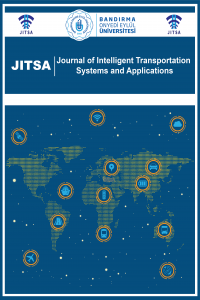Deniz Çevresi İzleme Amaçlı Kullanılan İnsansız Suüstü Araçların SWOT Analizi
Ticari denizcilik sayesnde yüksek miktarda taşınan yükler ile limanlar ticaret merkezleri haline gelmektedir. Bu büyük yapılar, tek noktadan denizlere açılan gemilerin neredeyse tüm ihtyaçlarını karşılayabilen, bölge için büyük öneme sahiptir. Deniz taşımacılığında, limanlar ticari gemiler için özel ihtiyaçlara hizmet etmektedir. Öte yandan Akıllı Ulaşım Sistemleri lojistik sektörü için ana başlıklardan birisi haline gelmiştir. AUS öncelikle güvenli, akıllı ve temiz mobiliteyi ve aynı zamanda enerji, zaman ve para tasarruflarını hedeflemektedir. Yüksek miktarda kargo ihtiyacı yüzünden limanlarda aşırı yoğun deniz trafiği meydana gelmektedir. Deniz çevresinin korunabilmesi için bu yüksek miktardaki trafiğin kontrol edilmesi gerekmektedir. Sürekli izlemenin en ucuz ve kolay yolu insansız ya da otonom su üstü araçlardır. Bu çalışmada, limanlarda kullanılabilen deniz çevresi izleme görevinde kullanılan insansız su üstü araçlarda kullanılan algılayıcıların SWOT analizi yapılmıştır. RF, LTE, Bluetooth ve WLAN teknolojileri algılayıcıların değişik özellikleri çerçevesinde karşılaştırılmıştır.
Anahtar Kelimeler:
Deniz Ulaşımı, SWOT, İnsansız Suüstü Araçlar
SWOT Analysis of Unmanned Surface Vehicle for Environmental Monitoring Tasks in Maritime Ports
Ports are becoming commercial centre due to large amounts of cargo transported via commercial shipment. These large structures, which can provide almost all the needs of the ships traveling on the high seas from a single point, have high importance for the region. In maritime transportation, ports serve special purposes for merchant vessels. On the other hand, Intelligent Transport Systems became the main target of logistic market. ITS’ primarily aim includes safe, smart and clean mobility and as well as saving on money, time and energy. Demand of high amounts of cargo operation causes high vessel traffic in maritime ports. For environmental protection all these merchant vessel traffic should be monitored. The easiest and cheapest way of continuously monitoring is unmanned or autonomous surface vehicles. In this study, SWOT analysis of unmanned surface vehicles is used for determining which communication sensor is suitable in ports. RF, LTE, Bluetooth and WLAN technologies are compared in the scope of different properties of sensors.
___
- Ferreira, H., Almeida, C., Martins, A., Almeida, J., Dias, N., Dias, A., & Silva, E. (2009). Autonomous bathymetry for risk assessment with ROAZ robotic surface vehicle. OCEANS ’09 IEEE Bremen: Balancing Technology with Future Needs, 1–6. https://doi.org/10.1109/OCEANSE.2009.5278235
- Horner, D. P., & Healey, A. J. (2004). Use of artificial potential fields for UAV guidance and optimization of WLAN communications. 2004 IEEE/OES Autonomous Underwater Vehicles (IEEE Cat. No.04CH37578), 88–95. https://doi.org/10.1109/AUV.2004.1431198
- Howard, V., Mefford, J., Camilli, R., Bingham, B., & Arnold, L. (2017). The Unmanned Port Security Vessel: An autonomous platform for monitoring ports and harbors. OCEANS’11 MTS/IEEE KONA, 1–8. https://doi.org/10.23919/oceans.2011.6107217
- Ireland, R. D., Hitt, M. A., & Sirmon, D. G. (2003). Recent research on team and organizational diversity: SWOT analysis and implications. Journal of Management, 29(6), 801–830. https://doi.org/10.1016/S0149-2063
- Johansen, T. A., Zolich, A., Hansen, T., & Sorensen, A. J. (2014). Unmanned aerial vehicle as communication relay for autonomous underwater vehicle - Field tests. 2014 IEEE Globecom Workshops, GC Wkshps 2014, 1469–1474. https://doi.org/10.1109/GLOCOMW.2014.7063641
- Leirens, S., & Pierquin, J. (2004). Modelling and Control of an UNMANNED SURFACE VEHICLE FOR ENVIRONMENTAL MONITORING, 81(October), 1032–1040. https://doi.org/10.1002/(SICI)1099-1239(199706)7:6<591::AID-RNC293>3.0.CO;2-M
- Liu, Y., & Bucknall, R. (2015). Path planning algorithm for unmanned surface vehicle formations in a practical maritime environment. Ocean Engineering, 97, 126–144. https://doi.org/10.1016/j.oceaneng.2015.01.008
- Stelzer, R., & Jafarmadar, K. (2012). The robotic sailing boat asv roboat as a maritime research platform. INNOC Austrian Society for Innovative Computer Sciences. Retrieved from http://www.hiswasymposium.com/assets/files/pdf/2012/Stelzer.pdf
- TSUGAWA, S. (2005). Issues and Recent Trends in Vehicle Safety Communication Systems. IATSS Research, 29(1), 7–15. https://doi.org/10.1016/S0386-1112(14)60113-8
- Zhao, Z., Liu, D., & Wang, L. (2018). Applicability Analysis of LTE in Long-distance Maritime Communication, 161(Tlicsc), 128–132.
- ISSN: 2636-820X
- Yayın Aralığı: Yılda 2 Sayı
- Başlangıç: 2018
- Yayıncı: Bandırma Onyedi Eylül Üniversitesi
Sayıdaki Diğer Makaleler
Toplu Ulaşımda Akıllı kart Kullanımının Değerlendirilmesi ve Seul Örneği
Mükemmel/İdeal Şehir içi Ulaşım Sisteminin Diğerleriyle Karşılaştırılması: Toplam Seyahat Zamanları
Akıllı ulaşım sistemleri(AUS) uygulamalarının sektörlere göre dağılımı
Deniz Çevresi İzleme Amaçlı Kullanılan İnsansız Suüstü Araçların SWOT Analizi
